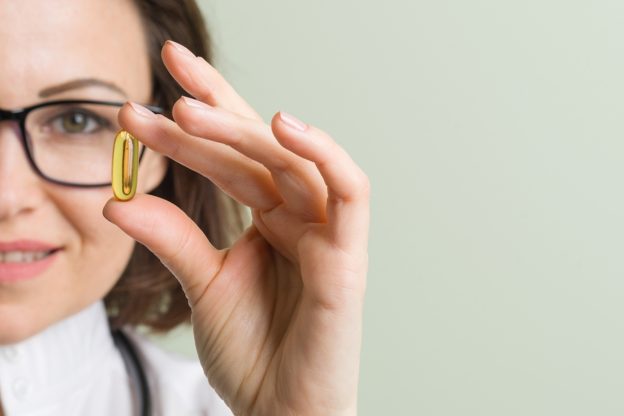By David Blyweiss, M.D., Advanced Natural Wellness
July 16, 2018
- Vitamin D: The anti-cancer vitamin
- 77% of cancer patients have low levels of the sunshine vitamin
- Here’s how to bring your vitamin D levels up to par
You’ve been told to stay out of the sun… that it will give you skin cancer. But that advice is only partially true. It is intense, intermittent exposure (like that from tanning beds and a full day on the beach once in a while) and the burning that subsequently occurs that increases the risk of skin cancer, specifically melanoma.
As a result of this constant advice to avoid sun exposure, vitamin D deficiency is running rampant here in the U.S. As a matter of fact, it’s estimated that as many as three out of every four people have vitamin D insufficiency.
This means you only have about a 25% chance of having adequate levels of vitamin D. And guess what happens when you your vitamin D levels run low? Your risk of several different types of cancer rises… including your chances of developing skin cancer.
You see, low vitamin D levels are associated with an increased risk of – and worse prognosis for – melanoma. This type of skin cancer accounts for 75% of all skin cancer deaths.
And here’s the thing. The highest rates of melanoma in the U.S. aren’t in the hot, sunny states like Florida, Texas, Arizona and Hawaii where you would expect them to be. Instead, they’re in the northern states.
Utah has the highest rate of new melanoma per capita. This is followed by Vermont, Minnesota, New Hampshire, Delaware, Idaho and Maine. These are all areas that are too far from the equator to get adequate sunlight for vitamin D production on a year-round basis.
Open your arteries, improve blood flow for a new health miracle...
Did you know your circulatory system has over 60,000 miles of arteries, veins and other blood vessels, if stretched end to end?
But as you age, your blood vessels undergo changes, which may cause them to stiffen, thicken and get clogged.
GOOD NEWS! Doctors have now identified a “Miracle Molecule” inside your arteries that helps OPEN your arteries and IMPROVE blood flow.
It’s what Dr. Valentin Fuster calls it, "One of the most important discoveries in the history of cardiovascular medicine."To you, that means...
- Healthy blood pressure
- Sharper mind and memory
- Skyrocketing energy and muscular strength
- Increased pleasure and passion in the bedroom
- Improved circulation to every cell and organ in your body
Go here to discover a new natural way to significantly boost the levels of this miracle molecule in YOUR body NOW!
In addition to increased rates of skin cancer, vitamin D is also associated with the incidence (and death rates) of colon, breast, prostate, ovarian and liver cancers.
This makes the epidemic of vitamin D deficiency a big problem when it comes to the fight against cancer. And it’s one of the first things that needs to be addressed.
Cancer Patients have Low Levels of Vitamin D
If you are concerned about cancer, here’s a statistic that you absolutely must be made aware of…
As many as 77% of cancer patients have either
deficient or suboptimal levels of vitamin D.
Now, current guidelines say that levels of less than 20 ng/ml are deficient, and below 30 ng/ml are insufficient. Everything above 30 ng/l is considered adequate.
But today we’re finding that these cut-offs may be set way too low. I certainly don’t agree with them.
Are You Suffering From...
- Love handles and a pot belly
- Romance that isn't what it used to
- Forgetfulness and inattention
- Low (or no) strength and endurance
- A sex drive that's shifted into neutral...or worse
If so...you may have Mature Male Burnout. Click here to discover more about this unique condition and what you can do about it.
For example, higher vitamin D levels decrease the risk of colon cancer. In fact, every 10 ng/ml increment in vitamin D concentrations lowers colorectal cancer risk by about 19% in women and 7% in men. This puts optimal levels near the 40 ng/ml mark or higher if you want to protect against colon cancer.
Additionally, higher levels of vitamin D improve survival rates in patients who have colon cancer.
And when it comes to breast cancer, women with blood level concentrations of vitamin D that are above 60 ng/ml have about one-fifth the risk of breast cancer than those with less than 20 ng/ml.
Plus breast cancer patients with the highest vitamin D levels have about a 50% lower fatality rate than those with lower levels.
Bringing Your Vitamin D Levels up to Par
Unfortunately, it’s almost impossible to maintain adequate levels of vitamin D year-round, especially if you live north of Atlanta. And if live in the south, slathering sunscreen all over yourself every time you go outside doesn’t help much either.
That’s why I recommend having your vitamin D levels measured. All you have to do is ask your doctor for a 25-hydroxy vitamin D test. Set your goal for maintaining levels of at least 40-50 ng/ml. (If you have been diagnosed with an autoimmune disease closer to 65 ng/ml is better.)
- If your levels are 30 ng/ml or lower, take at least 8,000 IU of vitamin D3 in the cholecalciferol form (better if it has low dose vitamin K2 and even better with a bit of vitamin A too) each day and retest in three months.
- If your levels are 31 to 40 ng/ml, supplement with a 5,000 IU daily combination for three months. Then retest.
- If your numbers are over 40, you’re not deficient. Still, it’s a good idea to take 2,000-4,000 IU daily to maintain sufficient levels.
SOURCES:
Bade B, et al. Low serum 25-hydroxyvitamin d concentrations are associated with increased risk for melanoma and unfavourable prognosis. PLoS One. 2014 Dec 1;9(12):e112863.
Timerman D, et al. Vitamin D deficiency is associated with a worse prognosis in metastatic melanoma. Oncotarget. 2017 Jan 24;8(4):6873-6882.
Field S, et al. Vitamin D and melanoma. Dermatoendocrinol. 2013 Jan 1; 5(1): 121–129.
Melanoma Cancer Rates by State. U.S. Cancer Statistics Working Group. U.S. Cancer Statistics Data Visualizations Tool, based on November 2017 submission data (1999-2015): U.S. Department of Health and Human Services, Centers for Disease Control and Prevention and National Cancer Institute. June 2018.
Garland CF, et al. The Role of Vitamin D in Cancer Prevention. Am J Public Health. 2006 February; 96(2): 252–261.
Insufficient Vitamin D Levels Frequently Present in Cancer Patients. News Article.
Journal of Hematology Oncology Pharmacy. Oct 2011.
McCullough ML, et al. Circulating Vitamin D and Colorectal Cancer Risk: An International Pooling Project of 17 Cohorts, JNCI: Journal of the National Cancer Institute. June 2018. djy087.
University of California – San Diego. “Greater levels of vitamin D associated with decreasing risk of breast cancer.” ScienceDaily. June 2018.
Mohr SB, et al. Meta-analysis of vitamin D sufficiency for improving survival of patients with breast cancer. Anticancer Res. 2014 Mar;34(3):1163-6.
Holick MF, Siris ES, Binkley N, et al: Prevalence of vitamin D inadequacy among postmenopausal North American women receiving osteoporosis therapy. J Clin Endocrinol Metab. 2005;90(6):3215-3224
Heaney RP: Vitamin D: how much do we need, and how much is too much? Osteoporos Int. 2000;11:553-555







Hello, I tried to follow the link in the article ” The World’s Quickest Solution for Ending Prostate and Urinary Misery” but I can’t reach the page . an you please assist me in getting this article.
Hello Kehinde,
Please try using this link: https://www.theunisciencegroup.com/prosterin/new/?campaign=ANW10
Thank you!